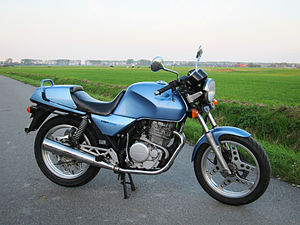bike.wikisort.org - Motorcycle
The Honda XBR 500 is a 500cc Japanese sports motorcycle launched by Honda in 1985 and in response to the Yamaha SR500. It is powered by a single-cylinder four-valve engine with the valves arranged radially relative to the geometric centre of the hemispherical combustion chamber - (Honda's Radial Four Valve Combustion Chamber, or RFVC) and actuated via intermediate sub-rockers. Displacing 498 cc (30.4 cu in) and producing 27 or 44 hp (depending upon specific market legislation),[citation needed] the engine, having its origins in the Honda XR series off-road models, features a "quasi-dry sump", the bulk of the oil being stored in a separate tank below the seat but a proportion (ca. 0,5 litres) of the lubricant remaining in the crankcase sump. The steel-braided hoses connecting the oil tank to the engine (clearly visible at the right-hand side of the motorcycle) are a strong visual element.
This article needs additional citations for verification. (January 2020) |


The two exhaust valves enabled the motorcycle to be fitted with two separate exhaust systems. The motorcycle had both an electric start and a kick start.[1] On earlier models, the kick start was linked by a cable to an exhaust valve decompressor to reduce cylinder compression during manual engine starting; later examples incorporated the valve lifter with the camshaft which also assisted in reducing the starter motor loads. The fuel-efficient engine combined with the large fuel tank capacity (20 litres/5,28 US galls) provided the bike with a long range (typically well in excess of 200 miles) between refueling.[2]
XBR500s (F,G and some H sub-types) were fitted with 18" Comstar wheels and tubeless tyres, 100/90 front and 110/90 rear. The frame was of a single-downtube, dual-cradle design having a box-section swinging arm and conventionally sprung rear suspension. The last iterations - some XBR500H and all XBR500SJ types - were supplied with traditional wire wheels and tubed tyres. The XBR500 is a fine-handling machine with sprightly performance and a wheelbase of 1,400 mm (55 in). A detachable pillion seat cover was supplied to simulate a café-racer look, but Honda subsequently released a dedicated café racer version of near-identical mechanical specification although of less power - the Honda GB500 TT - which featured some "classic British qualities", such as a solo seat, seat hump, wire wheels, two-into-one exhaust system and a fuel-tank with gold pinstriping reminiscent of the earlier AJS and Velocette machines.[1]
References
- Hewitt, Sam (23 January 2019). "Turning Japanese: Honda's XBR500". Classic Motorcycle Mechanics. Retrieved 17 January 2020.
{{cite web}}: CS1 maint: url-status (link) - "7 brilliant big singles". Motorcycle News. 5 January 2016. Retrieved 17 January 2020.
{{cite web}}: CS1 maint: url-status (link)
На других языках
[de] Honda XBR 500
Die XBR 500 (PC 15) ist ein Motorrad der japanischen Firma Honda, welches 1985 von Honda als Antwort auf die Yamaha SR 500 auf den Markt gebracht wurde. Der Antrieb erfolgt durch einen Einzylindermotor mit vier Ventilen und einem Hubraum von 499 cm³. Die Motorleistung des Viertaktmotors beträgt ungedrosselt 44 PS.- [en] Honda XBR500
[it] Honda XBR 500
La Honda XBR 500 è una motocicletta da prodotta dalla casa motociclistica giapponese Honda dal 1985 al 1988.Другой контент может иметь иную лицензию. Перед использованием материалов сайта WikiSort.org внимательно изучите правила лицензирования конкретных элементов наполнения сайта.
WikiSort.org - проект по пересортировке и дополнению контента Википедии